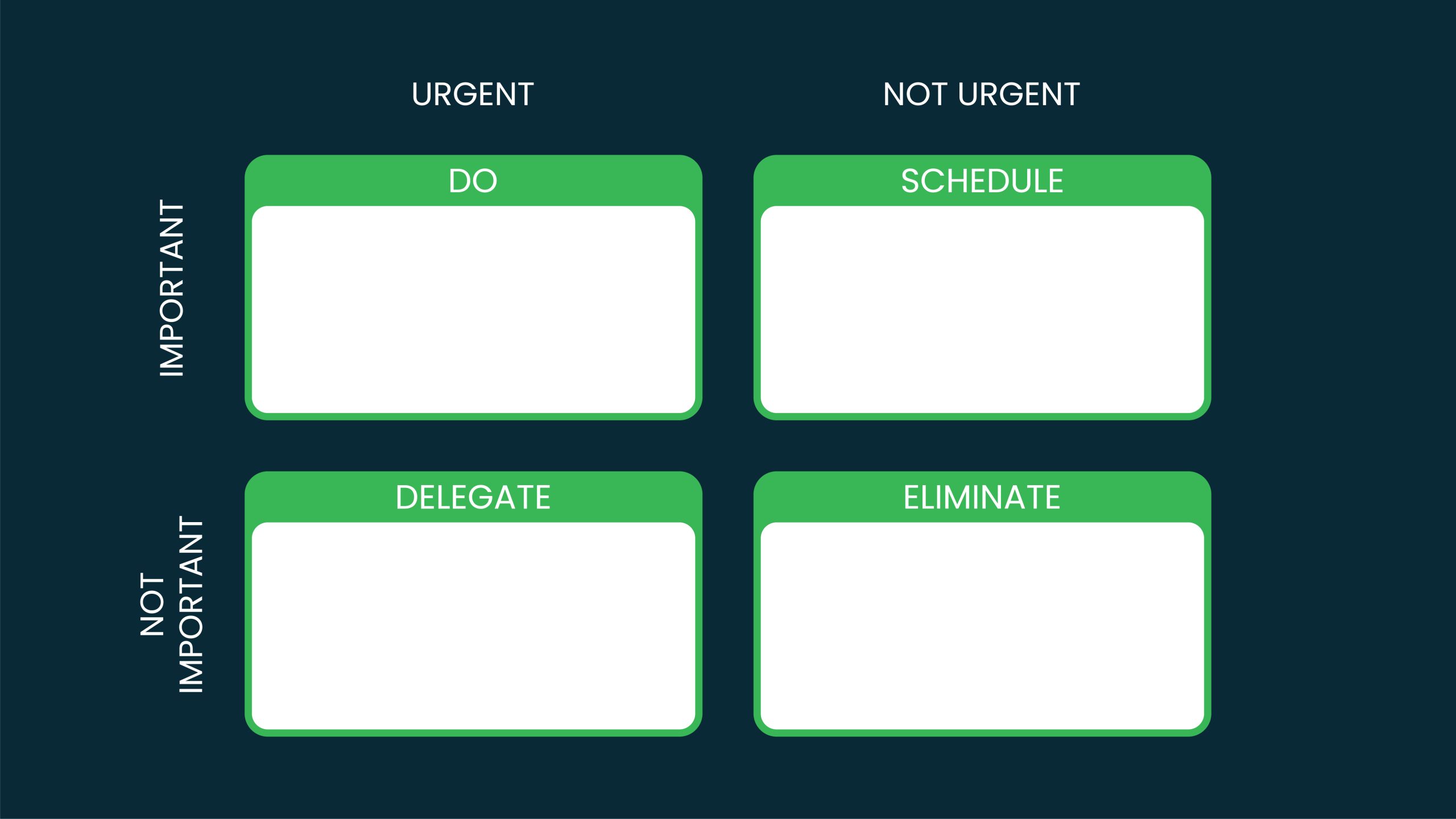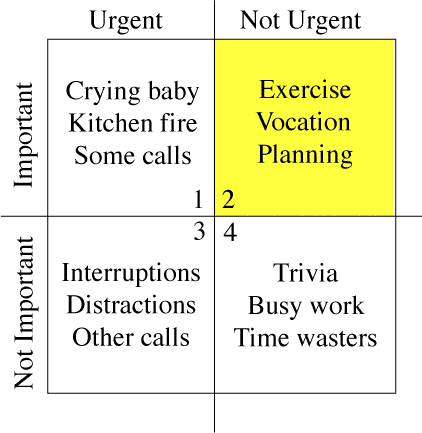Chapter 4: Time Management & Goals
Chapter Learning Objectives
- 4.1 Apply the concepts of fixed and free time to create a personalized weekly schedule that reflects academic, personal, and professional priorities. (SLO 4)
- 4.2 Evaluate the effectiveness of current time management strategies in relation to goal achievement and stress reduction. (SLO 4)
- 4.3 Identify and utilize time management tools. (SLO 4)

“Time is the only commodity that matters.” – Randy Pausc
My favorite aspect of time is its equality.
Regardless of our race, religion, or age, all of us have the same amount of time in a day, week, month and year. Wealthy people cannot buy more time and poor people do not receive less time. A minute for a tall person is the same amount of time for a short person.
An hour for a woman is the same amount of time for a man. Regardless of how many languages someone speaks, their sexual orientation, ethnicity, educational background, income or experience, we all have 365 days in a year. Some people will live longer than others, but when comparatively measuring how much time humans have with each other, we all have the same amount.
Time is a popular philosophical concept. You may have heard some of the following sayings:
- Time flies when you are having fun
- That is a waste of time
- Time is money
- We have all the time in the world
- That was an untimely death
- The time is right
- I’m having the time of my life
- Time heals all wounds
- We have some time to kill
What do the sayings mean to you? Time is also how we keep track of when we’re supposed to be and where we’re supposed to be (work, home, class, meeting friends and family, etc.). Think about how many measures of time you have in your home (clocks, watches, cell phones, TVs, DVRs, computers, microwaves, ovens, thermostats, etc.). With this many reminders of time in our lives, it is obvious time is important to us.
Time: A Limited and Precious Commodity
We cannot go back in time.
If I used my time poorly last Wednesday, I cannot do anything to get it back. Other commodities may allow for accumulating more or starting over, but time does not. We cannot “save” time nor earn more time.
“If you had a bank that credited your account each morning with $86,400, but carried no balance from day to day and allowed you to keep no cash in your account, and every evening cancelled whatever part of the amount you had failed to use during the day, what would you do? Draw out every cent, of course!
Well, you have such a bank, and its name is time.
Every morning it credits you with 86,400 seconds. Every night it writes off as lost whatever of these you have failed to invest to good purpose. It carries no balance; it allows no overdrafts. Each day it opens a new account with you. Each night it burns the record of the day.
If you fail to use the day’s deposit, the loss is yours. There is no going back. There is no drawing against the morrow. You must live in the present – on today’s deposit. Invest it so as to get the utmost in health and happiness and success.” – Anonymous
Technically, time cannot be managed, but we label it time management when we talk about how people use their time. We often bring up efficiency and effectiveness when discussing how people spend their time, but we cannot literally manage time because time cannot be managed. What we can do though, is find better ways to spend our time, allowing us to accomplish our most important tasks and spend time with the people most important to us.
Human babies do not come with instruction manuals. There is nothing to follow to know how we are “supposed” to spend our time. Most of us spend our time doing a combination of what interests us, what is important to us and what we feel we “have” to do.
What is your relationship with time? Are you usually early, right-on time or are you often late? Do you find yourself often saying, “I wish I had more time?” Are you satisfied with your relationship with time, or would you like to change it?
The Value of Time
It is also important to determine how much your time is worth to you.
If someone were to negotiate for an hour of your time, how much would that be worth to you? We often equate time with money. Many of us work in positions where we are paid by the hour; this gives us some gauge of what we are worth to our employers. Some items we purchase because we think they are of good value for their price. Others we pass on.
Are some hours of your day more important or more valuable than others? Why? Are you more productive in the morning or in the evening?
Once people realize how valuable time is, they often go to great lengths to protect it because they understand its importance. How much would you pay for an additional hour in a day? What would you do with that time? Why?
What is the value of your time? How much is an hour of your time worth? If someone were to pay you $10 to do a job, how much time would that be worth? $20? $50?
How Do I Allocate My Time?
Most of us know there are 24 hours in a day, but do you know how many hours are in a week?
There are 168 hours in a week (24 hours multiplied by seven days). Knowing 168 hours helps when we start to look at how we want to spend our time vs. how we actually spend our time.
One challenge for many students is the transition from the structure of high school to the structure of college. In high school, students spend a large portion of their time in class (approximately 30 hours in class per week), while full-time college students may spend only one-third of that time in class or working independently on classwork. Think about how many times one of your high school teachers gave you something to read during class. In college, students are given more material to read with the expectation that it is done outside of class.
This can create challenges for students who are unable to set aside proper study time for each of their courses. Keep in mind for full-time students: your college educational day should not be shorter than your high school day.
I like to ask students how they spend their week. Students always know their work hours and their class times. These are easy to place in a schedule or on a calendar because they are predetermined. But study time, or asynchronous online learning, are areas that consistently left out of a student’s written schedule. Being a college student takes initiative and self-discipline to stick to a schedule.
Here’s a tip: Write your study time into your schedule or calendar. It’s important to do this because it’s easy to skip a study session or say to yourself, “I’ll do it later.” The more specific you can be about what you will study during that time, the better the chances will be that you don’t ignore the time and use it to get the work done that you know you have to do.
While there would likely be an immediate consequence if you do not show up for work, there is not one if you fail to study on Tuesday from 3pm-4pm. That consequence may take place later, if the studying is not made up. It is widely suggested that students need to study approximately two hours for every hour that they spend in class in order to be successful.1

How do you spend your 168 hours in a week?
- Child Care
- Class
- Community Service / Volunteer
- Commuting / Transportation
- Eating / Food Preparation
- Exercise
- Family
- Friends
- Household / Child Care Duties
- Internet / Social Media / Phone / Texting
- Parties
- Personal hygiene time (showering, hair, makeup, etc.)
- Recreation / Leisure
- Relationship
- Sleeping
- Spirituality / Prayer / Meditation
- Study
- Video Games
- Watching TV or Movies, Netflix, YouTube
- Work / Career
Do all of these areas positively impact your personal and professional goals?
Not So Obvious Uses of Time
Sometimes we know exactly how long a task is going to take us. A 30 second “short” video by itself is just 30 seconds, but when you add up multiple videos, an hour, or more, can easily go by. Additionally, some tasks take us longer as we are learning. Do you remember how slow you used to go when you first started riding a bike with two wheels? Even the training wheels slowed you down. But the more experience you gained on the bike, the faster you could go.
There is also the time it takes for college students to adjust to college culture, college terminology, and college policies. You may need to learn or relearn how to learn and some students may need to learn what they need to know. What a student in their first college semester needs to know may be different than what a student in their last college semester needs to know. Whatever it is students may need to learn, it takes time.
Fixed Time vs. Free Time
Sometimes it helps to take a look at your time and divide it into two areas: fixed time and free time.
Fixed time is time that you have committed to a certain area. It might be school, work, religion, recreation or family. There is no right or wrong to fixed time and everyone’s is different. Some people will naturally have more fixed time than others.
Free time is just that—it is free. It can be used however you want to use it; it’s time you have available for activities you enjoy. Someone might work 9am-2pm, then have class 3pm-4:30pm, then have dinner with family 5pm-6pm, study 6pm-7pm and then have free time from 7pm-9pm.
Take a look at a typical week for yourself. How much fixed time do you have? How much free time? How much fixed and free time would you like to have?
Identifying, Organizing, and Prioritizing Goals
The universal challenge of time is that there are more things that we want to do and not enough time to do them. I talk to students frequently who aspire, dream, set goals for want they want to accomplish. Similarly, I ask students to list their interests at the beginning of each of my classes and there is never a shortage of items.
But I often talk to students who are discouraged by the length of time it is taking them to complete a goal (completing their education, reaching their career goal, buying a home, getting married, etc.). And every semester there are students who drop classes because they have taken on too much or they are unable to keep up with class work because they have other commitments and interests. There is nothing wrong with other commitments or interests. We have to be honest about our goals and the 168 hours we have in a week to reach all those goals in our life.
If you were to drop a class because you required surgery, needed to take care of a sick family member or your boss increased your work hours, those may be important and valid reasons to do so. If you were to drop a class because you wanted to binge watch the latest series on Netflix, play more Minecraft, or spend more time posting on social media, you may have more difficulty justifying that decision, but it is still your decision to make. Sometimes students do not realize the power they have over the decisions they make and how those decisions can affect their ability to accomplish the goals they set for themselves.
Re-Visiting Your Goals
Goal identification is a way to allow us to keep track of what we would like to accomplish as well as a mechanism to measure how successful we are at achieving our goals. Your goals hopefully include education, professional and personal goals. Re-visiting your goals and making sure your time supports the work your goals are going to take is a great way to keep focused and increases your chances of meeting your goals!
Educational Planning
As a college student, you know the importance of educational planning. It took planning your goals to get to this point of being enrolled in this course. Hopefully enrolling was just the first step in your planning process. Education plans developed with a college counselor can help students determine and explore a program of study and have proven to facilitate student success,
Students can follow educational plans like a road map so they can see how to complete required classes in the most efficient and logical order based on their educational goals.
Educational planning may appear to be simple: identifying the program of study and then figuring out which courses are required to complete it. However, course requirements, time management, financial questions, and truly understanding your interest may make planning extremely complex.
Many students have multiple goals for short and long-term educational planning. Students also have different strengths. Some might be strong in writing. Some students excel in math. Others might be strong in science, arts and humanities, or social sciences. Educational planning takes these strengths (and weaknesses) into consideration.

Many times, schools attempt to set students up for success with recommended classes. For example, students are encouraged to take English and math early as statistics show that those students will be more successful. But the order of courses taken for students with different strengths could vary even if the students have the same goal. There is not a one-size-fits-all solution.
Educational planning may be further complicated by availability of courses a college or university offers, the process in which a student may be able to register for those courses and which sections fit into students’ schedules. Transcript evaluations (if students have attended previous colleges or universities), assessment of appropriate English or math levels and prerequisite clearance procedures may also contribute to the challenge of efficient educational planning.
Further, students have different priorities. Some students want to complete their goals in a certain amount of time. Other students may have to work full-time and take fewer units each semester. Educational planning might also consider student interests, skills, values, personality, or student support referrals. Grade point average requirements for a student’s degree, transfer or specific programs are also considered in educational planning.
Beyond Education
While some students may know what they want to do for their career, and have known since they were five years old, many students are unsure of what they want to do. Often, students aren’t sure how to choose their major. A major is an area of concentration in which students will specialize at a college or university. Completing a major requires passing courses in the chosen concentration and degrees are awarded that correlate with students’ majors. Many students change their major during their studies as they find what they like (or don’t like) studying or what they learn about future jobs those degrees might offer. Changes are alright to find your path, but every change brings complications to your plan to reach the ultimate goal to graduate.
Due to the complicated nature of educational planning and the requirements of various professions, a counselor or academic advisor can provide great value for students with assistance in creating an educational plan, specifically for each individual student. If you have not done so already, I highly recommend you meet with a school advisor and continue to do so on a frequent basis (once per semester if possible). Ask them questions and understand the schedule they help you build for your short-term and long-term goals.
How Time Management Can Help You Reach Your Goals
Without goals, we aren’t sure what we are trying to accomplish, and there is little way of knowing if we are accomplishing anything. If you already have a goal-setting plan that works well for you, keep it. If you don’t have goals, or have difficulty working towards them, I encourage you to try this.
Make a list of all the things you need or want to do for the next day. Including both things you “have” to do and things you will enjoy doing are important to include on the same list.
Here is a sample to-do list:
- Go to the grocery store
- Go to class
- Pay bills
- Exercise
- Social media
- Study
- Eat lunch with friend
- Work
- Watch TV
- Text friends
Your list may be similar to this one or it may be completely different. It is yours, so you can make it however you want. Do not be concerned about the length of your list or the number of items on it as long as you are being realistic with yourself about what is on the list.
You now have the framework for what you want to accomplish. Hang on to that list. We will continue to think about it in this chapter.
Now take a look at the upcoming week, the next month and the next year. Make a list of what you would like to accomplish in each of those time frames. If you want to go jet skiing, travel to Europe, or get a bachelor’s degree, write it down. Pay attention to details. The more detail within your goals the better. Ask yourself this question: what is necessary to complete each of those goals and write those down too?
Accountability
Another important aspect of goal setting is accountability. Someone could have great intentions and set up SMART goals for all of the things they want to accomplish. But if they don’t work towards those goals and complete them, they likely won’t be successful. It is easy to see if we are accountable in short-term goals.
Take the daily to-do list for example. How many of the things that you set out to accomplish, did you accomplish? How many were the most important things on that list? Were you satisfied? Were you successful? Did you learn anything for future planning or time management? Would you do anything differently? The answers to these questions help determine accountability.
Long-term goals are more difficult to create and it is more challenging for us to stay accountable. Think of New Year’s Resolutions. Gyms are packed and mass dieting begins in January. By March, many gyms are empty, and diets have failed. Why? Because it is easier to crash diet and exercise regularly for short periods of time than it is to make long-term lifestyle and habitual changes.
Pomodoro Method to Time Management
Making the most of your time to achieve your goals is a big promise, but we all often fall short. One common method is the Pomodoro Method.
Watch this TEDx video with a real student explaining her use of the Pomodoro Method and how she changed her thinking about how and when to get work done for her goals:
Video
Break Goals into Small Steps
I ask this question of students in my classes: If we decided today that our goal was to run a marathon and then went out tomorrow and tried to run one, what would happen? Students respond with: (jokingly) “I would die,” or “I couldn’t do it.” How come? Because we might need training, running shoes, support, knowledge, experience and confidence—often this cannot be done overnight.
An academic goal might be obtaining an A grade on a mid-term essay for a writing class. Small steps might include getting started, planning time for smaller tasks, researching, writing a draft, visiting a writing support service, having a friend proofread, revising. Instead of giving up and thinking it’s impossible because the task is too big for which to prepare, it’s important to develop smaller steps or tasks that can be started and worked on immediately. Once all of the small steps are completed, you’ll be on your way to accomplishing your big goals.
What steps would you need to complete the following big goals?
- Buying a house
- Finding a long-term partner
- Attaining a bachelor’s degree
- Destroying the Death Star
Prioritizing Goals

Why is it important to prioritize? Let’s look back at the sample list. If I spent all my time completing the first seven things on the list, but the last three were the most important, then I would not have completed the most important items on my list.
It would have been better to prioritize the list after creating it and then work on the items that are most important first. You might be surprised at how many students fail to prioritize.
After prioritizing, the sample list now looks like this:
- Go to class
- Work
- Study
- Pay bills
- Exercise
- Eat lunch with friend
- Go to grocery store
- Text friends
- Social media
- Watch TV
One way to prioritize is to give each task a value.
A = Task related to goals;
B = Important—Have to do;
C = Could postpone.
Then, map out your day so that with the time available to you, work on your A goals first. You’ll now see below our list has the ABC labels. You will also notice a few items have changed positions based on their label. Keep in mind that different people will label things different ways because we all have different goals and different things that are important to us. There is no right or wrong here, but it is paramount to know what is important to you, and to know how you will spend the majority of your time with the things that are the most important to you.
- A Go to class
- A Study
- A Exercise
- B Work
- B Pay bills
- B Go to grocery store
- C Eat lunch with friend
- C Text friends
- C Social media
- C Watch TV
Do the Most Important Things First
You do not have to be a scientist to realize that spending your time on “C” tasks instead of “A” tasks won’t allow you to complete your goals. The easiest things to do and the ones that take the least amount of time are often what people do first. Checking Facebook or texting might only take a few minutes but doing it prior to studying means we’re spending time with a “C” activity before an “A” activity.
People like to check things off that they have done. It feels good. But don’t confuse productivity with accomplishment of tasks that aren’t important. You could have a long list of things that you completed, but if they aren’t important to you, it probably wasn’t the best use of your time.
A Time Management Matrix is another way to show how to categorize your tasks and will help prioritize your goals, tasks, and assignments. Take a look at the matrix and quadrants and identify which quadrant your activities would fall into.
Quadrant I (Do): Important and Urgent
Only crisis activities should be here. If you have included exams and papers here, you are probably not allowing yourself enough time to fully prepare. If you continue at this pace, you could burn out!
Quadrant II (Schedule): Important and Not Urgent
This is where you define your priorities. What’s important in your life? What will keep you balanced? For example, you may know that good nutrition, sleep, recreation and maintaining healthy social relationships are important but do you consciously make time for them in your daily or weekly routine? This may be where school fits. Where would time for class, homework, study time, required reading, preparing for exams fit in your overall priorities? Quadrant II includes your “A” goals. Managing your life and the lifestyle will help you manage your time.
Quadrant III (Delegate): Not Important and Urgent
While you may feel that activities, such as texting, need your attention right away, too much time spent on Quadrant III activities can seriously reduce valuable study time. This may leave you feeling pulled in too many directions at once.
Quadrant IV (Eliminate): Not Important and Not Urgent
Quadrants three and four include your “C” goals. If you’re spending many hours on Quadrant IV activities, you’re either having a great deal of fun or spending a lot of time procrastinating! Remember, the objective is balance. You may notice I placed social media and texting into this category. You could make a case that social media, texting, Netflix, and YouTube are important, but how often are they urgent?
Ultimately, it is up to you to decide what is important and urgent for yourself, but for the context of this textbook, your classes, assignments, preparation, and studying should almost universally be more urgent and important than social media and texting.
Here is an adapted version of the matrix, with an emphasis on quadrant II.
Conclusion
Managing time well comes down identifying (and then prioritizing) goals and having the discipline to be able to work towards accomplishing them. We all have the same amount of time in a day, week, month and year, yet some people are able to accomplish more than others. Why? Often, it is because those who accomplish a lot are able to set goals, prioritize them and then work on them relentlessly and effectively until they are complete.
Exercises
To cite this specific chapter use this format:
Dillon, D. (n.d.). Chapter 4: Time Management and Goals. In Pouska, B. (Ed.), Business Professionalism. New Mexico Open Educational Resources Consortium Pressbooks. Https://nmoer.pressbooks.pub/businessprofessionalism/
Licenses and Attributions
CC Licensed Content — Original
Ocampo, M. G. (n.d.). Hop to it! [Creative work]. (Licensed under CC BY-ND 4.0.)
Vix, S. (n.d.). Setting intentions [Creative work]. (Licensed under CC BY 4.0.)
Version history: Minor edits and updates for currency, cohesiveness, inclusiveness, alignment, and cultural responsiveness (July 2021).
Content Previously Copyrighted (now CC-licensed)
Dillon, D. (n.d.). Blueprint for success in college: Indispensable study skills and time management strategies [Textbook]. (Original work published; now licensed under CC BY.)
All Rights Reserved Content
California Community Colleges Chancellor’s Office. (2012). Advancing student success in the California community colleges: Recommendations of the California Community Colleges Student Success Task Force. California Community Colleges.
Fleming, K., & Marsh, B. Y. (2017). Success in the new economy [Video]. Vimeo. Citrus College.
Pausch, R. (2008, February 6). Randy Pausch lecture: Time management [Video]. YouTube. Carnegie Mellon University.
Smith, B., et al. (n.d.). The role of counseling faculty and delivery of counseling services in the California community colleges. The Academic Senate for California Community Colleges.
Weissman, J., Bulakowski, C., & Jumisko, M. K. (1997). Using research to evaluate developmental education programs and policies. In J. M. Ignash (Ed.), Implementing effective policies for remedial and developmental education: New directions for community colleges (Vol. 100, pp. 73–80). Jossey-Bass.
Young, J. (2002). Homework? What homework? Chronicle of Higher Education, 49(12), A35–A37.




